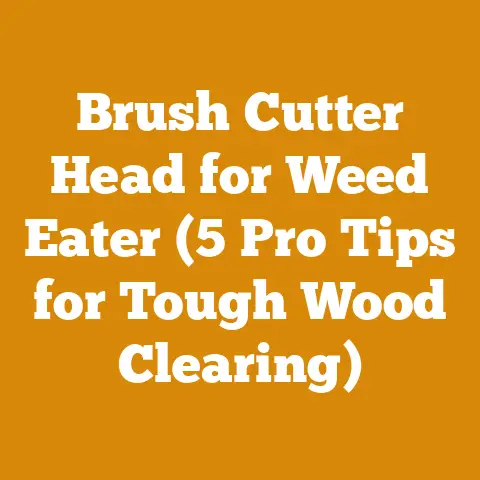Fir Wood Outside Durability (5 Pro Tips for Treating Douglas Fir)
For me, working with wood isn’t just a job, it’s a legacy.
I remember being a young boy, maybe eight or nine, watching my grandfather meticulously stacking firewood, each piece placed with a care that bordered on reverence.
He’d tell me stories about the forest, about respecting the trees, and about the satisfaction of heating your home with wood you’d harvested yourself.
Those memories, the smell of freshly cut timber, the rhythmic clang of the splitting maul, they’re ingrained in my soul.
Now, decades later, I find myself passing on that same knowledge to my own children, teaching them the skills and respect that were passed down to me.
One of the most common questions I get asked is about using Douglas Fir outdoors.
Everyone loves the look of it, the grain, the color, but they worry about its durability.
And rightfully so.
That’s why I’ve put together this guide: “Fir Wood Outside Durability: 5 Pro Tips for Treating Douglas Fir.” I’m going to share what I’ve learned over the years, the tricks of the trade, to help you ensure your Douglas Fir projects stand the test of time.
Let’s get started!
Fir Wood Outside Durability: 5 Pro Tips for Treating Douglas Fir
Douglas Fir is a beautiful and versatile wood, prized for its strength, straight grain, and appealing reddish-brown color.
It’s a favorite for everything from furniture to framing lumber.
That doesn’t mean you can’t use it outside, though!
With the right treatment and care, you can significantly extend the life of Douglas Fir in outdoor environments.
I’ve seen it firsthand – projects lasting decades with the proper approach.
Understanding the Challenge
Before we dive into the tips, let’s be clear about the challenges.
Douglas Fir is moderately durable, meaning it’s susceptible to decay if constantly exposed to moisture.
Think of it like this: untreated Douglas Fir left out in the rain is like leaving a sponge out to soak.
It’ll absorb water, and over time, that moisture will create the perfect breeding ground for fungi and insects, leading to rot and structural damage.
According to the U.S.
Forest Products Laboratory, untreated Douglas Fir typically lasts 5-10 years in ground contact situations.
That’s not exactly inspiring, is it?
But don’t despair!
With the right approach, we can dramatically improve those numbers.
Pro Tip #1: The Power of Proper Drying and Acclimation
This is where it all starts.
The moisture content of the wood is the single biggest factor affecting its durability.
Wood that’s too wet is an open invitation for decay.
Kiln-dried lumber is your best friend here.
Aim for lumber with a moisture content of 12-15% for exterior use in most climates.
I always use a moisture meter (they’re relatively inexpensive) to double-check before I start any project.
It’s a small investment that can save you a lot of headaches down the road.
Personal Story: I once built a beautiful outdoor bench using what I thought was properly dried Douglas Fir.
Within a year, I started noticing signs of rot in the legs.
Turns out, the lumber, while kiln-dried, hadn’t been properly acclimated to the outdoor environment.
It absorbed moisture from the air, and the rot set in.
Lesson learned: Always let your lumber acclimate to the outdoor environment for at least a week before starting your project.
Stack it loosely with spacers to allow for good air circulation.
Actionable Steps:
- Invest in a moisture meter: A reliable moisture meter will give you accurate readings and peace of mind.
- Kiln-dried is King: Always opt for kiln-dried lumber for outdoor projects.
- Acclimation is Key: Allow your lumber to acclimate to the outdoor environment for at least a week before use.
- Proper Stacking: Stack lumber loosely with spacers to allow for good air circulation during acclimation.
Pro Tip #2: Choosing the Right Preservative: A Deep Dive
This is where the science comes in.
Preservatives are designed to protect wood from decay, insects, and other environmental factors.
There are several types of preservatives available, each with its own strengths and weaknesses.
- Oil-Based Preservatives: These preservatives penetrate deeply into the wood, providing excellent protection.
They’re often used for projects that will be in direct contact with the ground.
Examples include creosote (though its use is restricted in some areas due to environmental concerns) and copper naphthenate. - Water-Based Preservatives: These preservatives are less toxic than oil-based preservatives and are easier to clean up.
They’re a good choice for projects where you’re concerned about environmental impact.
Examples include copper azole and alkaline copper quaternary (ACQ). - Borate Preservatives: Borate preservatives are effective against insects and fungi but are not as resistant to leaching as other types of preservatives.
They’re best suited for projects that are not in direct contact with the ground or exposed to constant moisture.
My Recommendation: For most outdoor Douglas Fir projects, I recommend using a water-based preservative like copper azole or ACQ.
They provide good protection, are relatively easy to apply, and are less toxic than oil-based preservatives.
Application is Everything: No matter which preservative you choose, proper application is critical.
Follow the manufacturer’s instructions carefully.
This usually involves applying multiple coats of the preservative, allowing each coat to dry thoroughly before applying the next.
In some cases, you may need to soak the wood in the preservative for a period of time.
Statistical Insight: Studies have shown that wood treated with preservatives can last up to 10 times longer than untreated wood in similar environments.
That’s a significant difference!
Actionable Steps:
- Research Preservatives: Understand the different types of preservatives and their pros and cons.
- Choose Wisely: Select a preservative that’s appropriate for your project and your environment.
- Follow Instructions: Follow the manufacturer’s instructions carefully when applying the preservative.
- Multiple Coats: Apply multiple coats of the preservative for maximum protection.
- Consider Soaking: For critical applications, consider soaking the wood in the preservative.
Pro Tip #3: Surface Protection: Seal the Deal
Preservatives are great for protecting the wood from the inside out, but they don’t always provide the best surface protection.
That’s where sealants, stains, and paints come in.
These products create a barrier that protects the wood from moisture, UV rays, and other environmental factors.
- Sealants: Sealants are clear coatings that penetrate the wood and create a water-resistant barrier.
They’re a good choice for projects where you want to preserve the natural look of the wood. - Stains: Stains add color to the wood while also providing some protection from the elements.
They’re available in a wide range of colors and opacities. - Paints: Paints provide the most protection from the elements, but they also completely cover the wood’s natural grain.
They’re a good choice for projects where you want to achieve a specific color or look.
My Preference: For Douglas Fir, I often use a combination of a sealant and a stain.
I apply a coat of sealant to protect the wood from moisture, and then I apply a stain to add color and enhance the wood’s natural grain.
I like to use a penetrating oil-based stain for this purpose.
Cheap products may look good initially, but they won’t hold up over time.
Invest in high-quality products from reputable brands.
Maintenance is Key: Even the best sealants, stains, and paints will eventually break down over time.
To keep your Douglas Fir projects looking their best, you’ll need to reapply these products every few years.
The frequency will depend on the product you use and the environment your project is exposed to.
Personal Experience: I built a deck using Douglas Fir and finished it with a cheap stain.
Within two years, the stain was peeling and fading, and the wood was starting to show signs of weathering.
I had to completely strip the deck and re-stain it with a high-quality product.
It was a lot of extra work and expense that could have been avoided by using the right product in the first place.
Actionable Steps:
- Choose the Right Finish: Select a sealant, stain, or paint that’s appropriate for your project and your desired look.
- Invest in Quality: Use high-quality products from reputable brands.
- Follow Application Instructions: Follow the manufacturer’s instructions carefully when applying the finish.
- Regular Maintenance: Reapply the finish every few years to keep your project looking its best.
Pro Tip #4: Design for Durability: Smart Construction Techniques
It’s not just about the wood and the treatments; it’s also about how you design and build your project.
Smart construction techniques can significantly extend the life of Douglas Fir in outdoor environments.
- Elevate from Ground Contact: Whenever possible, elevate your Douglas Fir projects off the ground.
This will reduce the amount of moisture that the wood is exposed to.
Use concrete piers, treated lumber, or other durable materials to create a barrier between the wood and the ground. - Proper Drainage: Ensure that your projects have proper drainage.
Water should be able to run off easily without pooling or collecting on the wood.
This can be achieved by sloping surfaces, adding drainage holes, or using waterproof membranes. - Air Circulation: Good air circulation is essential for keeping wood dry.
Design your projects to allow for plenty of airflow around the wood.
This will help to prevent moisture from accumulating and creating a breeding ground for decay. - Use Stainless Steel Fasteners: Galvanized or coated fasteners will corrode over time, leading to rust stains and potential structural failure.
Stainless steel fasteners are more expensive, but they’ll last much longer and won’t damage the wood. - Avoid Water Traps: Design your projects to avoid creating water traps.
These are areas where water can collect and remain for extended periods of time.
Common water traps include joints, corners, and areas where surfaces meet.
Example: When building a deck, I always use pressure-treated lumber for the framing and Douglas Fir for the decking.
I also make sure to leave small gaps between the deck boards to allow for proper drainage and air circulation.
Finally, I use stainless steel screws to fasten the decking to the framing.
Data Point: A study by the University of Minnesota found that decks built with proper drainage and air circulation lasted up to 50% longer than decks built without these features.
Actionable Steps:
- Elevate from Ground: Elevate your projects off the ground whenever possible.
- Ensure Drainage: Design your projects to have proper drainage.
- Promote Air Circulation: Design your projects to allow for good air circulation.
- Use Stainless Steel: Use stainless steel fasteners to avoid corrosion.
- Avoid Water Traps: Design your projects to avoid creating water traps.
Pro Tip #5: Regular Inspection and Maintenance: The Long Game
Even with the best treatment and construction techniques, Douglas Fir will eventually require some maintenance.
Regular inspection and maintenance are essential for keeping your projects looking their best and preventing serious problems from developing.
- Annual Inspection: At least once a year, inspect your Douglas Fir projects for signs of damage, such as cracks, splits, rot, or insect infestation.
Pay close attention to areas that are exposed to moisture or are in contact with the ground. - Address Problems Promptly: If you find any signs of damage, address them promptly.
Small problems can quickly become big problems if they’re not taken care of. - Clean Regularly: Clean your Douglas Fir projects regularly to remove dirt, debris, and mildew.
This will help to prevent the growth of fungi and other organisms that can damage the wood. - Reapply Finish: Reapply sealant, stain, or paint as needed to protect the wood from the elements.
The frequency will depend on the product you use and the environment your project is exposed to. - Replace Damaged Wood: If you find any wood that is severely damaged or rotted, replace it immediately.
This will help to prevent the damage from spreading to other parts of the project.
Personal Anecdote: I have a wooden fence made of Douglas Fir that I built over 20 years ago.
I inspect it every spring, and I’ve had to replace a few posts and pickets over the years.
But because I’ve been diligent about maintenance, the fence is still in good condition and looks great.
Cost Savings: Regular maintenance can save you a lot of money in the long run.
By addressing small problems early, you can prevent them from becoming big problems that require expensive repairs or replacements.
Actionable Steps:
- Annual Inspections: Conduct annual inspections of your projects.
- Prompt Repairs: Address any problems promptly.
- Regular Cleaning: Clean your projects regularly.
- Reapply Finish: Reapply sealant, stain, or paint as needed.
- Replace Damaged Wood: Replace any severely damaged or rotted wood.
Bonus Tip: Sustainable Sourcing Matters
While not directly related to treatment, I feel it’s important to mention sustainable sourcing.
Choosing Douglas Fir from sustainably managed forests is not only good for the environment, but it can also ensure that you’re getting high-quality lumber that’s been properly harvested and processed.
Look for lumber that’s certified by the Forest Stewardship Council (FSC) or other reputable organizations.
Challenges and Solutions
Working with Douglas Fir outdoors isn’t always a walk in the park.
Here are some common challenges and solutions I’ve encountered over the years:
Challenge: Checking and Splitting: Douglas Fir is prone to checking and splitting, especially in hot, dry climates.
- Solution: Use lumber that’s been properly dried and acclimated.
Apply a sealant or stain to help prevent moisture loss.
Design your projects to minimize stress on the wood. -
Challenge: Mold and Mildew: Douglas Fir is susceptible to mold and mildew growth, especially in damp, shady environments.
-
Solution: Ensure that your projects have proper drainage and air circulation.
Clean the wood regularly with a mild detergent and water.
Apply a mildewcide to prevent mold and mildew growth. -
Challenge: Insect Infestation: Douglas Fir is susceptible to insect infestation, especially by termites and carpenter ants.
-
Solution: Treat the wood with a preservative that’s effective against insects.
Inspect your projects regularly for signs of infestation.
Eliminate any sources of moisture that could attract insects.
- Solution: Use lumber that’s been properly dried and acclimated.
Current Trends and Best Practices
The wood processing and firewood production industries are constantly evolving.
Here are some current trends and best practices to keep in mind:
- Heat Treatment: Heat treatment is a process that involves heating wood to high temperatures to kill insects and fungi.
Heat-treated wood is more durable and resistant to decay than untreated wood. - Modified Wood: Modified wood is wood that has been chemically altered to improve its durability and resistance to decay.
There are several types of modified wood available, including acetylated wood and thermally modified wood. - Sustainable Harvesting Practices: Sustainable harvesting practices are becoming increasingly important.
These practices involve harvesting timber in a way that minimizes environmental impact and ensures the long-term health of the forest. - Automation and Technology: Automation and technology are playing an increasingly important role in wood processing and firewood production.
Automated machinery can improve efficiency, reduce labor costs, and improve safety.
Conclusion: Building for the Future
Using Douglas Fir outdoors can be a rewarding experience.
With the right treatment, construction techniques, and maintenance, you can create beautiful and durable projects that will last for years to come.
Remember, it’s not just about the wood; it’s about the craftsmanship, the attention to detail, and the commitment to quality.
These are the things that will make your projects stand the test of time and become a lasting legacy.
Key Takeaways:
- Proper drying and acclimation are essential for durability.
- Choose the right preservative for your project and environment.
- Surface protection with sealants, stains, or paints is crucial.
- Design your projects for durability with smart construction techniques.
- Regular inspection and maintenance are key to long-term success.
Next Steps:
- Assess your project needs and choose the appropriate treatment methods.
- Research and select high-quality products from reputable brands.
- Implement the construction techniques outlined in this article.
- Establish a regular inspection and maintenance schedule.
Now, go out there and build something amazing!
And remember, the best projects are the ones that are built with care, attention to detail, and a deep respect for the wood.
Happy woodworking!






